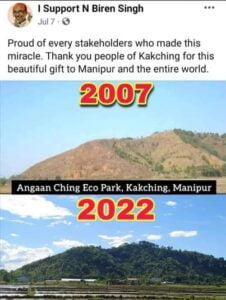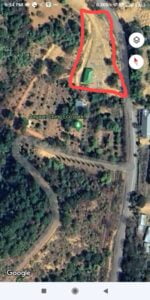The story with Angaan Ching is of local community coming out in a concerted effort to bring back the once-fully scrapped hillock to its near natural status. With Angaan Ching, the Alliance for Development Alternatives Manipur (ADAM) has since been leading the initiative to re-green the hillock, developing it as an ‘ecological park’ with the plantation of different varieties of trees, bushes, and herbs.

By Salam Rajesh
United Nations secretary-general Antonio Guterres observed on the floor of the UN General Assembly during 2021 that it is community-led conservation of forests and wetlands which is evidently succeeding on ground much better than government-led initiatives.
Against this statement which indicates proactive participation of local communities in saving and protecting forest lands from wanton destruction (by companies and other development agencies), it ironically is evident of States coming into conflict with local communities on the issue of “encroachment” by locals in ‘forest areas’ that communities assume as their “territory of life” or upon which they rely upon for their sustenance, or for other environment-related activities.
There are many stories of conflicts of interest between States and the local communities all across the globe on the touchy issue of ‘encroachment’ in forest lands, with certain non-clarity on the classification of the forest land itself and the rights of local people in forest areas that they have enjoyed generations after generations.
One of the perplexed issues in conservation is the conflict of interest over States’ assertion that locals ‘encroaches’ on forest areas that are not appropriately defined legally, such as the lack of clarity on the terminology “unclassified forest”, as to how locals access these ‘unclassified forest’ areas to source minor forest produces or where they are engaged in small activities for livelihoods or other ecological restoration activities.
Referring to the UN secretary-general’s statement, it is observed that local communities in many parts of the world are engaged in their individual capacities to save and protect forests from unwanted human interferences like timber logging, mining, slash and burn agriculture, over grazing, extractive industries, and many more. These protected forest lands are sustained by the local communities’ active engagement in conservation.
In Manipur, there are few instances where local communities have extended their activities in protecting forest lands out of their individual interests, and exemplary of the local effort at contributing to the global concerns on climate issues and specifically on the concerns of global warming.
Out of these few instances, as in the case of the central Manipur valley areas, local community’s involvement in proactive forest conservation can be seen at Phayeng village and Punshilok in the Langol hills as in Imphal West District, and Angaan Ching hillock in Kakching District.
As Guterres says, these are small instances where local communities are contributing significantly to the global effort in extending the green cover worldwide – like the 30 percent forest area coverage by the year 2050. Phayeng village is widely appreciated as a green village, and Loya Moirangthem has been appreciated nationwide for his singular contribution to re-greening Punshilok – which sometimes has been referred to as a ‘green lung’ for the highly urbanized Imphal area.
The story with Angaan Ching is again of local community coming out in a concerted effort at bringing back the once-fully scrapped hillock to its near natural status. With Angaan Ching, a local non-governmental organization – the Alliance for Development Alternatives Manipur (ADAM) – has since been leading the initiative to re-green the hillock, developing it as an ‘ecological park’ with the plantation of different varieties of trees, bushes, and herbs.
Angaan Ching comes under the definition of an ‘unclassed’ forest, legally administered under the Chandel Forest Division but in practice under the supervision of the Kakching range forest office due to a faulty administrative setup. Forest department has an impromptu understanding with the NGO-ADAM since the community is protecting the hillock in the absence of the forest department’s direct outreach in this ‘unclassed forest’.
Angaan Ching, unfortunately, inspite of people’s appreciation at the level of ADAM’s activity in re-greening the hillock during these past decades, is locked in a current spate of unfounded allegation from certain sectors that ADAM had illegally ‘encroached’ in this forest area.
On the first of last month, the local Member of the Legislative Assembly brought up a subject matter in the house that the NGO-ADAM had illegally encroached in this forest land and had engaged in non-forestry activity. The MLA’s blatant allegation was widely condemned by people long associated with ADAM’s activities to promote awareness on environment regeneration for near twenty years, and the long term conservation of the hillock.
Like the Langol hills in central Imphal, Angaan Ching is primarily seen as a ‘green lung’ for Kakching town, providing scenic landscape and free, vital oxygen in a highly urbanized area dominated by concretes and bereft of greenery. Succeeding heads of the Kakching District Administration had visited the hillock and appreciated the concerted effort at re-greening the hillock.

It understandably is largely seen by the public as irrational of the local MLA in accusing the NGO-ADAM for defiling the hillock by an illegal approach at occupying forest land. On the contrary, as the locals say, ADAM’s effort is highly appreciative for protecting the hillock from wanton destruction.
The counter argument is that at the initiative of the local MLA a portion of Angaan Ching hillock was partially damaged by physical modification for an ‘eco-tourism’ project. The north-eastern portion of the hillock was scrapped, dug up, and cleared of trees for a non-functional ‘tourist centre’ which again is completely of concrete structures and which primarily is a non-forestry activity in forest land.
The irony of the matter is that the local MLA had accused ADAM of engaging in non-forestry activity by constructing ‘kutcha huts’ within Angaan Ching while over-looking the fact that his own activity with the eco-tourism project is completely concrete in structure and violates the provision of the Forest Conservation Act, 1980, which discourages non-forestry activities in forest lands.

The tussle apart, the State’s forest department ought to acknowledge the singular achievement of the NGO-ADAM in successfully re-greening and protecting Angaan Ching from random destruction and encroachment by vested interests. If at all the UN secretary-general’s statement has any implication for the State, the forest department needs to support the encouraging work of ADAM as exemplary of community-led initiative in forest ecosystem restoration, as is explicitly outlined by the United Nations in its Decade on Ecosystem Restoration targets.
(The writer looks at environmental stories through the journalistic lens. He can be reached at [email protected])
